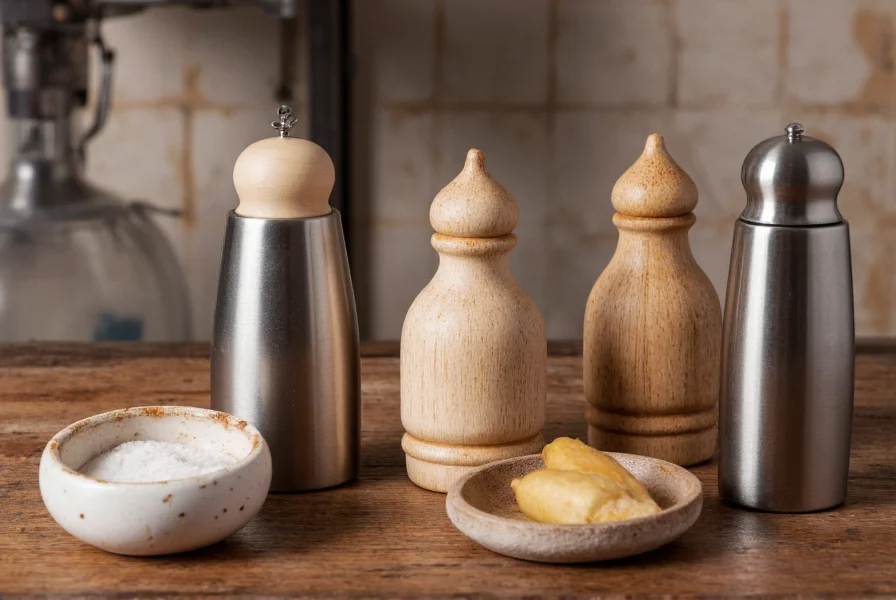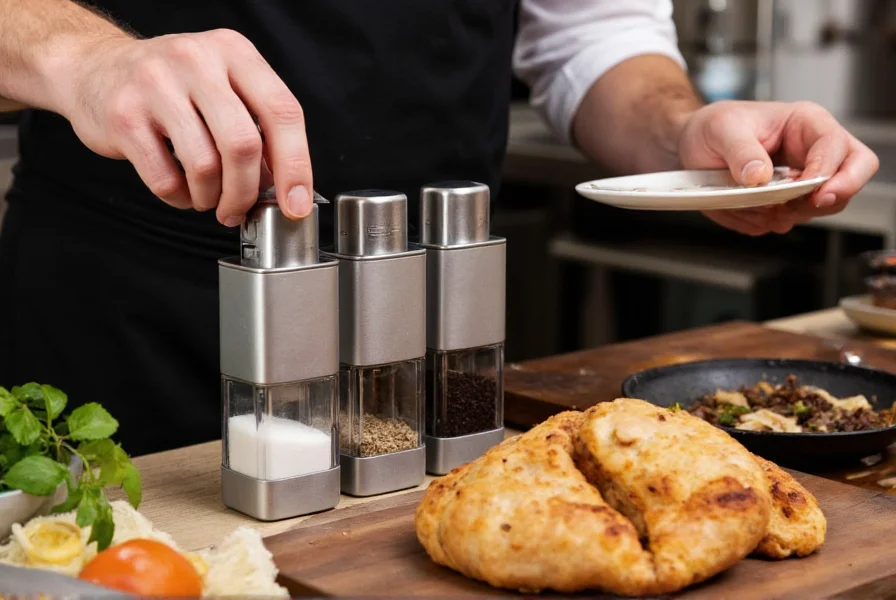Understanding the nuances of salt and pepper sets transforms a simple dining accessory into a culinary enhancement tool. The right set not only serves practical seasoning needs but also complements your table setting while preserving the integrity of your spices. This comprehensive guide explores the technical aspects, material considerations, and functional features that distinguish exceptional salt and pepper sets from ordinary tableware.
The Evolution of Salt and Pepper Dispensing Systems
Historically, salt cellars and pepper pots evolved from status symbols in medieval Europe to everyday tableware. Salt's value as a preservative made it a luxury item displayed in elaborate containers, while pepper—imported at great expense from Asia—was similarly treated as a precious commodity. The modern salt and pepper set emerged in the 19th century as both seasonings became more accessible, with the first patent for a combined salt and pepper shaker granted in 1842.
Material Science Behind Premium Salt and Pepper Sets
The material composition significantly impacts both functionality and longevity. Different materials interact uniquely with salt and pepper, affecting flavor preservation and mechanical performance.
| Material Type | Corrosion Resistance | Flavor Preservation | Lifespan Expectancy |
|---|---|---|---|
| Stainless Steel | Excellent (316 grade) | High (non-reactive) | 15+ years |
| Ceramic | Good | Moderate (porous) | 5-10 years |
| Wood (Teak/Beech) | Fair (requires maintenance) | Excellent (natural antimicrobial) | 10-15 years with care |
| Acrylic | Poor (scratches easily) | Low (static attracts particles) | 2-5 years |
Grinder Mechanisms: Engineering Flavor Preservation
The grinding mechanism represents the most critical functional element in premium pepper mills and salt grinders. Unlike basic shakers that dispense pre-ground particles, quality grinders control particle size distribution, which directly impacts flavor release and culinary application.
Ceramic grinding mechanisms maintain consistent performance with both wet and dry salts, resisting corrosion from mineral compounds. Carbon steel mechanisms provide sharper initial grinding but require occasional replacement due to salt corrosion. Precision-engineered mechanisms with adjustable grind settings allow customization from fine powder to coarse crystals—essential for different culinary applications.
For salt applications, consider sets with specialized ceramic mechanisms designed specifically for salt's crystalline structure. Standard pepper mechanisms often fail prematurely when used with salt due to mineral corrosion.
Design Considerations for Optimal Functionality
When selecting a salt and pepper set, evaluate these critical design elements:
- Ergonomic handling - Sets should balance comfortably in hand with textured grips that prevent slipping during use
- Capacity-to-base ratio - Optimal sets maintain stability with a base diameter at least 60% of total height
- Dispensing precision - Look for mechanisms with adjustable apertures controlling particle flow rate
- Sealing systems - Effective sets incorporate airtight seals to prevent moisture absorption in salt
- Visual differentiation - Distinct tactile or visual markers help identify salt versus pepper without looking
Maintenance Protocols for Longevity
Proper care significantly extends the functional life of your salt and pepper set. Follow these evidence-based maintenance practices:
For ceramic and glass sets: Hand wash only with mild detergent, avoiding abrasive cleaners that can scratch surfaces. Completely disassemble grinding mechanisms every 3-6 months for thorough cleaning. Never submerge grinding mechanisms in water—instead, use a soft brush to remove residue.
Wooden sets require periodic treatment with food-safe mineral oil to prevent drying and cracking. Avoid prolonged exposure to direct sunlight which can cause warping. Store in a cool, dry place away from humidity fluctuations.
Stainless steel sets benefit from occasional polishing with a microfiber cloth to maintain luster. Check grinding mechanisms quarterly for wear, especially when used with coarse salts that accelerate component degradation.
Matching Sets to Culinary Applications
Different cooking styles demand specific salt and pepper set characteristics. Professional chefs often prefer larger capacity sets with rapid dispensing mechanisms for high-volume cooking, while home entertainers might prioritize aesthetic appeal and compact storage.
For everyday family use, consider sets with child-safe locking mechanisms that prevent accidental spills. Restaurant settings typically require commercial-grade durability with standardized refill systems. Gourmet applications benefit from sets with multiple grind settings to accommodate different salt varieties (fleur de sel, Himalayan pink, smoked salts) and pepper types (Tellicherry, Sarawak, Szechuan).

Avoiding Common Selection Mistakes
Many consumers make critical errors when selecting salt and pepper sets that compromise long-term satisfaction:
- Using the same grinding mechanism for both salt and pepper (salt corrodes standard mechanisms)
- Choosing purely based on aesthetics without considering ergonomics
- Ignoring capacity needs relative to household size
- Selecting sets with non-replaceable grinding mechanisms
- Overlooking the importance of visual/tactile differentiation between salt and pepper containers
Investing in a quality salt and pepper set represents a small but significant enhancement to your dining experience. By understanding the material science, mechanical engineering, and practical considerations behind these seemingly simple tableware items, you can select a set that delivers both functional excellence and aesthetic harmony for years to come.
Frequently Asked Questions
Can I use the same grinder mechanism for both salt and pepper?
No, you should not use identical grinding mechanisms for salt and pepper. Salt's crystalline structure and hygroscopic nature corrode standard carbon steel mechanisms designed for pepper. Quality sets include separate mechanisms—ceramic for salt (corrosion-resistant) and carbon steel for pepper (optimal sharpness). Using the wrong mechanism significantly reduces lifespan and affects seasoning consistency.
How often should I clean my salt and pepper grinder mechanisms?
Ceramic grinding mechanisms for salt should be cleaned every 2-3 months, while pepper mechanisms require cleaning every 4-6 months. Regular cleaning prevents clogging and maintains consistent grind quality. Never submerge grinding mechanisms in water—instead, disassemble and use a soft brush with dry rice to absorb moisture and remove residue, followed by thorough air drying before reassembly.
What's the ideal particle size for table salt versus cooking salt?
Table salt for finishing dishes benefits from a medium-coarse grind (0.5-1mm particles) that provides texture and controlled flavor release. Cooking salt used during food preparation works best with a finer grind (0.2-0.5mm) for even distribution. Premium salt and pepper sets with adjustable mechanisms allow switching between these settings based on culinary application, enhancing both flavor control and dining experience.
Why do wooden salt and pepper sets require special maintenance?
Wooden salt and pepper sets require periodic treatment with food-safe mineral oil because wood is hygroscopic—it absorbs moisture from the air and from salt. Without proper maintenance, wooden sets can crack, warp, or develop mold. Apply mineral oil every 2-3 months, allowing full absorption before use. Never wash wooden sets in dishwashers or soak them in water, as this accelerates deterioration of the wood fibers.
How can I tell if a salt and pepper set has good ergonomics?
A well-designed salt and pepper set should rest comfortably in your hand with a diameter that fits naturally between thumb and fingers (typically 1.5-2 inches). When holding the set at a 45-degree angle, it should remain stable without requiring excessive grip strength. Textured areas should provide secure handling without sharp edges. Test the dispensing mechanism—turning should require consistent, moderate resistance that doesn't cause hand fatigue during extended use.











 浙公网安备
33010002000092号
浙公网安备
33010002000092号 浙B2-20120091-4
浙B2-20120091-4